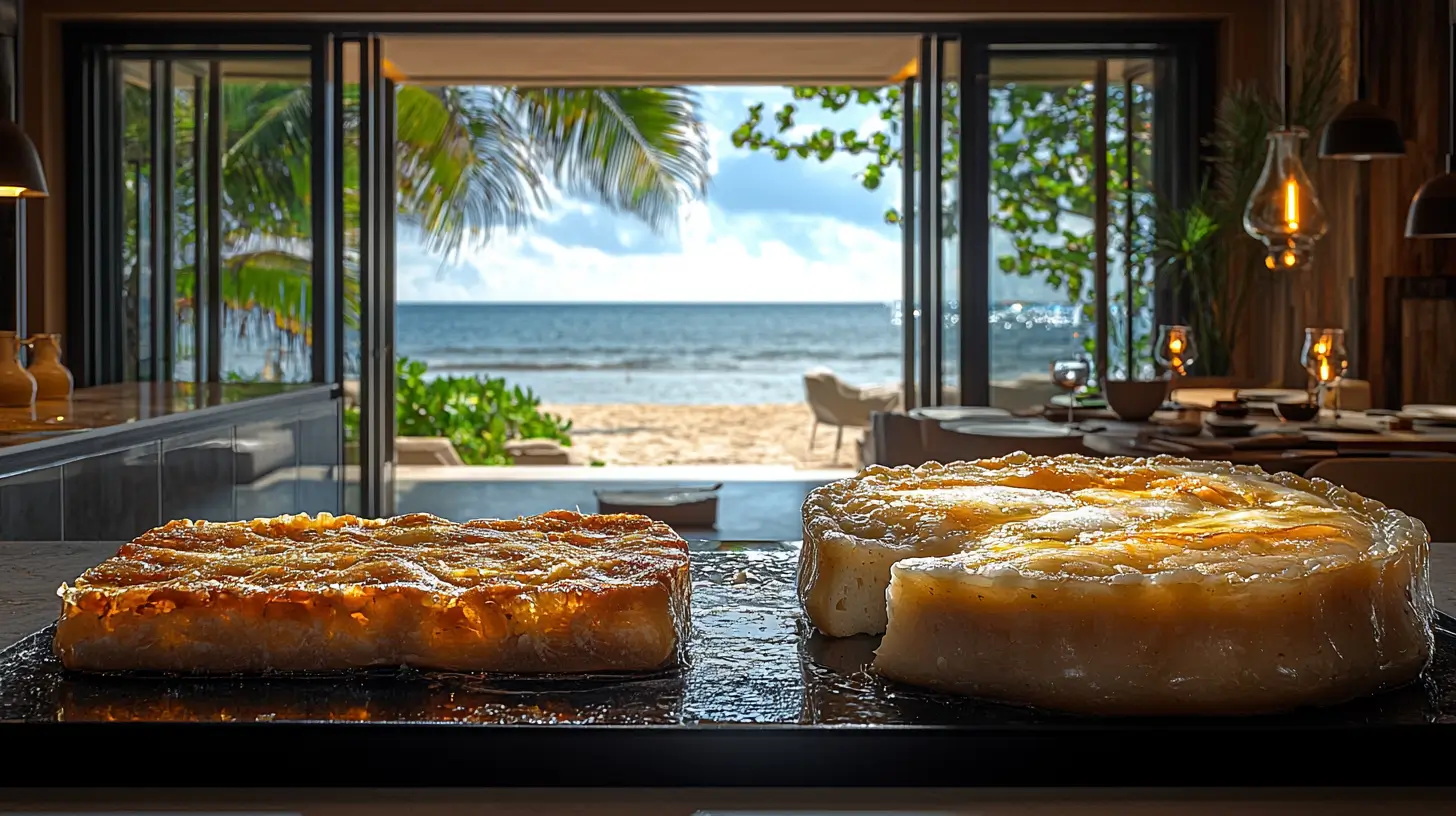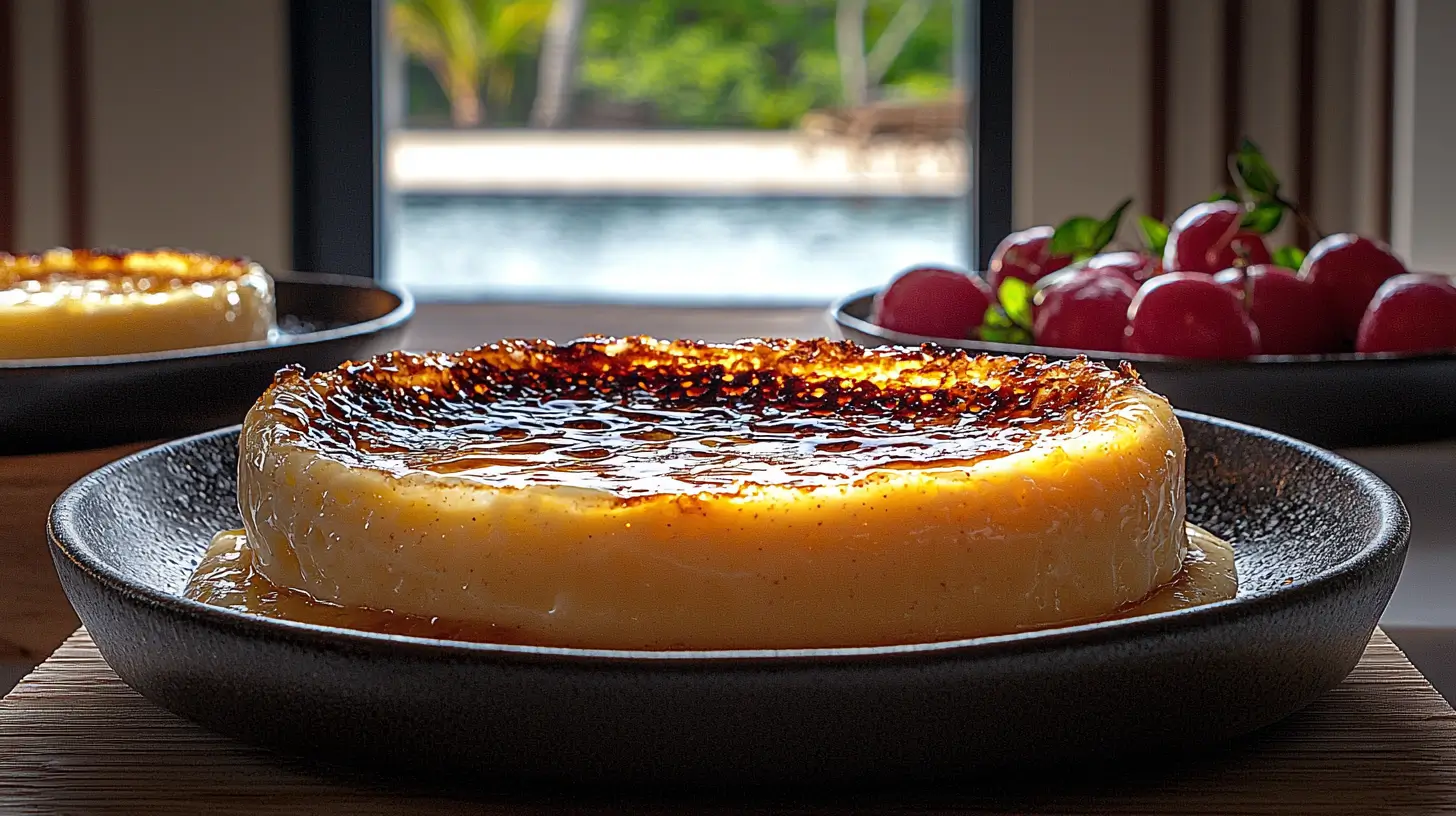Introduction
When it comes to classic desserts, crème brûlée and custard are two favorites that often come to mind. Both are creamy, decadent, and rich, making them perfect treats for special occasions or a fancy dinner at home. But if you’ve ever wondered, “Is crème brûlée the same as custard?” you’re not alone. These two desserts share similarities but are distinct in their own right.
Crème brûlée, with its iconic caramelized sugar topping, offers a contrast of textures that delights the palate. Custard, on the other hand, comes in various forms, from the velvety smoothness of a flan to the delicate wobble of a baked custard. In this article, we’ll dive deep into what makes these two desserts unique, exploring their textures, cooking methods, and ingredients, so you’ll never confuse them again.

What is Crème Brûlée? Is It Just a Fancy Custard?
Crème brûlée, translating to “burnt cream” in French, is a sophisticated dessert known for its silky, smooth custard base and a thin, crunchy layer of caramelized sugar on top. This dessert is traditionally served in individual ramekins, where the sugar is torched just before serving, creating a satisfying crack as you break into it with a spoon.
The base of crème brûlée is a rich custard made from heavy cream, egg yolks, sugar, and vanilla. It is baked in a water bath at a low temperature, ensuring the custard sets without curdling. The result is a smooth, creamy interior that contrasts beautifully with the brittle sugar topping.
What is Custard? How Does It Compare to Crème Brûlée?
Custard is a broad term that refers to a variety of sweet and savory dishes made by blending eggs with milk or cream and then cooking it until thickened. The most common form of custard is sweet, used in desserts like pies, tarts, and puddings. It can be cooked in several ways, such as baking, steaming, or stirring over low heat on the stovetop.
Custards vary widely in texture, from the pourable consistency of a crème anglaise to the firm, sliceable texture of a flan or baked custard. The key ingredients in custard are eggs, milk or cream, and sugar, though flavorings like vanilla, lemon zest, or nutmeg are often added. Custards can be served hot or cold and are used as a filling, topping, or standalone dessert.
Key Differences Between Crème Brûlée and Custard: Are They Really the Same?
Although crème brûlée is technically a type of custard, several differences set it apart from other custards. Let’s explore these key distinctions.
Texture and Consistency
The most notable difference between crème brûlée and other custards lies in their texture. Crème brûlée is known for its creamy, almost velvety texture that melts in your mouth, thanks to its high cream content and gentle baking process. The top layer of caramelized sugar adds a delightful crunch, creating a contrast with the soft custard below.
Custards, on the other hand, can range from runny to firm, depending on how they’re prepared. For example, a crème anglaise is a pourable custard sauce, while a flan is a firm, sliceable dessert. The texture of custard is influenced by the ratio of eggs to milk or cream and the cooking method used.
Cooking Techniques
Crème brûlée is always baked in a water bath (bain-marie) to ensure even cooking and prevent the eggs from curdling. This gentle cooking method allows the custard to set perfectly while retaining its creamy consistency. Once the custard has cooled, sugar is sprinkled on top and caramelized using a kitchen torch or broiler.
Custards, however, can be prepared in various ways. They can be baked, like in the case of a flan or pot de crème, or cooked on the stovetop, like a crème anglaise or pastry cream. Some custards, like a stovetop pudding, thicken through constant stirring, while others set in the oven.
Ingredients
While the basic ingredients of custard (eggs, milk or cream, and sugar) are similar, crème brûlée typically uses a higher ratio of cream to milk, giving it its signature richness. The use of just egg yolks in crème brûlée, as opposed to whole eggs, also contributes to its silky texture.
Custards might use whole eggs, just egg yolks, or even a combination, depending on the desired texture. For example, a baked custard might use whole eggs for a firmer set, while a crème anglaise uses only yolks for a smooth, pourable consistency.
Serving Styles
Crème brûlée is typically served in small, individual ramekins, allowing each guest to enjoy their own dessert with the perfect ratio of custard to caramelized sugar. The dessert is served cold, with the warm, freshly torched sugar providing a contrast in temperature and texture.
Custard can be served in many forms. It might be presented in a large dish for slicing, as in the case of a flan, or served as a sauce alongside other desserts. Custard desserts can be served warm or cold, depending on the type.
Why These Desserts Are Often Confused
It’s easy to see why crème brûlée and custard are often confused. Both desserts share a similar base of eggs, sugar, and cream, leading to their creamy textures. Furthermore, the fact that crème brûlée is a type of custard adds to the confusion.
However, the key distinctions lie in their preparation and final presentation. Crème brûlée’s iconic caramelized sugar topping is a defining feature that sets it apart from other custards. Additionally, the richer cream base and specific baking technique used in crème brûlée contribute to its unique texture and flavor.
Variations of Crème Brûlée and Custard
Both crème brûlée and custard can be adapted to suit various tastes and dietary needs, with many flavor variations and modifications available.
Flavor Variations
Crème brûlée, while traditionally flavored with vanilla, can be made with a variety of flavors. Popular variations include chocolate, coffee, citrus, and even exotic options like lavender or matcha. The base custard remains the same, but the flavoring agents are infused into the cream before baking.
Custards are incredibly versatile, with endless flavor possibilities. Classic custard flavors include vanilla, caramel, and chocolate. However, custards can also be infused with fruit purees, spices, or liqueurs, making them adaptable to a wide range of dessert recipes.
Dietary Modifications
Both desserts can be modified to fit dietary restrictions. For those who are lactose intolerant, crème brûlée can be made with lactose-free cream or plant-based alternatives like coconut cream. Similarly, custards can be adapted with almond milk, oat milk, or other non-dairy options.
For a lower-sugar version of either dessert, sugar substitutes like stevia or monk fruit can be used. However, achieving the perfect caramelized top on crème brûlée may require experimenting with different sugar alternatives to ensure proper caramelization.
Tips for Making the Perfect Crème Brûlée and Custard: Mastering These Similar Yet Distinct Desserts
Creating the perfect crème brûlée or custard at home requires attention to detail and a few helpful tips. For a detailed, step-by-step guide on making crème brûlée, check out our Crème Brûlée Recipe to get started with this classic dessert. Here are some additional strategies to ensure success:
- Use Fresh Ingredients: Start with the freshest eggs and cream you can find. Fresh ingredients will give your dessert the best flavor and texture.
- Temper Your Eggs: When making custards, it’s essential to temper the eggs by slowly adding hot cream or milk to them. This prevents the eggs from curdling and ensures a smooth texture.
- Avoid Overcooking: Custards should be cooked gently and slowly. Overcooking can cause them to curdle or develop an unpleasant, grainy texture. For crème brûlée, the custard should jiggle slightly when done but not be liquid in the center.
- Torching the Sugar: When caramelizing the sugar on crème brûlée, use a kitchen torch for the best results. Move the torch in a circular motion to evenly melt the sugar without burning it.
Common Mistakes to Avoid
Even experienced cooks can run into issues when making crème brûlée or custard. Here are some common mistakes and how to avoid them:
- Curdling the Custard: This happens when the eggs are overheated or cooked too quickly. Always cook custards at a low temperature and be patient.
- Skipping the Water Bath: For baked custards like crème brûlée, a water bath is crucial. It helps regulate the temperature and prevents the custard from becoming rubbery.
- Using Cold Eggs: Cold eggs can cause the custard mixture to separate. Allow your eggs to come to room temperature before mixing.
- Burning the Sugar: When torching the sugar on crème brûlée, it’s easy to go from caramelized to burnt. Watch closely and remove the torch as soon as the sugar melts and turns golden.
Conclusion
So, is crème brûlée the same as custard? While crème brûlée is indeed a type of custard, it is a distinct dessert with unique characteristics that set it apart. The rich, creamy custard base, paired with a crisp caramelized sugar topping, makes crème brûlée a favorite among dessert lovers. Understanding the differences between crème brûlée and other custards can help you appreciate each dessert’s unique qualities and choose the perfect one for any occasion.
Whether you’re enjoying the satisfying crack of crème brûlée or the smooth richness of a classic custard, both desserts offer a delightful treat. Try experimenting with different flavors and techniques to create your own variations at home, and savor the creamy goodness that these desserts bring.
Frequently Asked Questions (FAQs)
1. Can I make crème brûlée without a torch?
Yes, you can caramelize the sugar under a broiler. Place the ramekins close to the heat source and watch carefully to avoid burning the sugar. However, a kitchen torch gives you better control and more even caramelization.
2. What’s the best way to store leftover crème brûlée?
Crème brûlée is best eaten fresh, but if you have leftovers, cover the ramekins with plastic wrap and refrigerate for up to two days. Add the sugar topping and caramelize just before serving.
3. Can I freeze custard?
Most custards don’t freeze well as they can separate upon thawing. However, some frozen custard desserts, like ice cream, are specifically designed to be frozen and can be stored in the freezer.
4. Why did my custard turn out grainy?
Grainy custard is often the result of overcooking or cooking at too high a temperature. Ensure you cook custard slowly and at a low temperature to maintain a smooth texture.
5. Can I make a dairy-free version of crème brûlée?
Yes, crème brûlée can be made dairy-free by substituting the cream with coconut cream or another non-dairy alternative. The flavor will be slightly different, but it will still be delicious!
With this guide, you’re well-equipped to distinguish between crème brûlée and custard, master their preparation, and even adapt them to suit your preferences. Happy baking!


